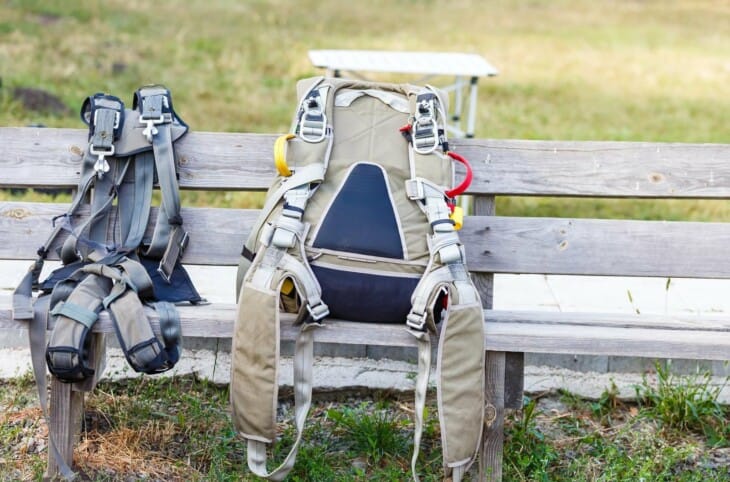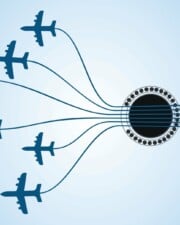It may seem obvious that commercial flights should be equipped with parachutes, but that is not the case. Since commercial planes do not provide passengers with parachutes, are travelers allowed to bring their parachutes on board?
Passengers on commercial flights are allowed to bring a parachute on board as a carry-on or checked-in luggage. The Transport and Security Administration (TSA) states that parachutes must be packed separately from other luggage and that TSA agents may inspect the bag containing the parachute.
Are Parachutes Allowed On Planes?
According to TSA, passengers may bring parachutes on planes in both their carry-on and checked-in luggage. Both parachutes with or without Automatic Activation Devices are permitted on commercial flights.
TSA does specify that passengers who bring parachutes must pack them separately from other luggage, as a TSA agent may want to inspect the parachute in question. In the event of an inspection, the parachute’s owner must be present to assist the TSA agent.
Unfortunately, if the parachute’s owner is not present during an inspection, the parachute will not be accepted on the flight. It is recommended that passengers traveling with parachutes arrive at the airport early to account for the possible delay of an inspection and repacking of parachutes.
Why Are There No Parachutes On Commercial Flights?
Commercial airlines take security concerns very seriously. At the beginning of every flight, the safety videos and cabin crew give detailed instructions to follow in an emergency. Planes are equipped with oxygen masks and life vests, but they never have parachutes for passengers on board.
There are many reasons why commercial planes are not equipped with parachutes for each passenger. Such reasons include:
- The lack of necessary parachute training
- High altitude and speed of commercial flights
- Design of commercial planes
- The costs of having a parachute for every person on board
Parachuting Is A Skill That Requires Training
Maybe it comes from watching too many movies where protagonists make it look easy, but people do not realize how difficult parachuting is. It is a skill that requires many hours of training.
When beginning to parachute or skydive, novices first jump from a plane attached to an experienced instructor. It is unheard of for people to do their first jumps solo, as several hours of theoretical and practical training are required to get to that level.
Judging by people’s first reactions to free falling from ten thousand feet, in which they feel utterly overwhelmed, passengers doing their very first jump (out of a crashing plane) from a commercial flight lack all the skill and training to survive and land safely.
Commercial Flights Fly Too High For Parachuting
Some people do not realize that commercial airplanes fly extremely high, making it nearly impossible to skydive from such high altitudes. Commercial planes usually cruise at altitudes of thirty-five thousand feet, whereas the most extreme skydives are around sixteen thousand feet high.
At such high altitudes, simply having a parachute is not enough to survive such a free fall. At thirteen thousand feet, the air is not breathable, so every passenger would need a high-tech oxygen mask and cylinders to avoid passing out from hypoxia (lack of oxygen).
It is completely unfeasible to expect passengers who have never put on a parachute to perform such ridiculously high and unplanned skydives that require all this equipment to be strapped on at a moment’s notice while panicking.
Commercial Flights Are Too Fast For Parachuting
On top of flying at extremely high altitudes, commercial flights travel at very high speeds. The average commercial plane cruises at around five hundred miles per hour, far from a skydiving-friendly speed. Planes used for skydiving typically cruise at around one hundred miles per hour.
So, if passengers were to jump out of a plane flying five times faster than the standard speed of skydiving planes, the result would probably be catastrophic in the form of serious or fatal injuries to various parts of the body, such as the neck.
Commercial Airplanes Are Not Designed For Jumps
Even if commercial planes reduced their speeds by a factor of four to enable passengers to jump without breaking their necks, the plane’s overall design is not suited for people to jump out of it.
Skydiving planes are typically small, so there is very little chance that a skydiver could hit a part of the plane right after jumping out. Though skydives do occur from bigger planes, like military planes, these are specifically designed for people to jump out of.
Big planes used for skydiving and parachuting have big ramps at the back that significantly reduce the risk of hitting any part of the plane upon jumping. Since commercial planes have no ramps, there is a serious risk of something going wrong when jumping out in panic.
It Is Expensive And Impractical To Have Parachutes On Plane
Assigning parachutes to every passenger on a commercial flight is impractical regarding space, weight, and cost.
Airlines would have to find space where there is none to put hundreds of parachutes. In addition, parachutes are not light; if you have one for every person, the plane will gain an additional seven thousand pounds. Not to mention the other necessary gear previously mentioned.
Adding extra weight is something commercial airlines want to avoid, as it increases the cost of the journey. It simply does not make any sense financially for airlines to spend money on parachutes that add extra weight to the plane, which ultimately would drastically increase the flight ticket price.
Most Commercial Airplanes Incidents Occur On The Ground
Another reason for not stocking planes with parachutes is that most commercial plane incidents happen during take-off or landing.
Since less than ten percent of incidents occur while the plane is at a high enough altitude for a skydive, it is impractical to invest so much money in an emergency protocol that it is highly likely to fail anyway.
Do Commercial Airline Pilots Have Parachutes?
Much like passengers, pilots on commercial flights do not have parachutes for themselves on board. This comes as no surprise as parachuting from a commercial flight, even when well trained in skydiving, is incredibly risky.
In addition, if there is an issue with the plane, it is up to the pilots to attempt to recover control of the plane.
Can Commercial Planes Have Whole-Plane Parachutes?
Since it is not feasible to have a parachute for every passenger, perhaps the next best thing is to have a whole plane parachute.
The main problem with putting a whole-plane parachute on commercial planes relates to weight and size. Commercial planes like a Boeing-737 or Airbus A380 are extremely heavy, requiring an insanely big parachute that would be difficult and expensive to design and manufacture.
To give you some idea of just how difficult and impractical it would be to equip a large commercial plane with parachutes, a standard Boeing 747 would need twenty-one parachutes the size of a football field.
References ▾
Related Posts












